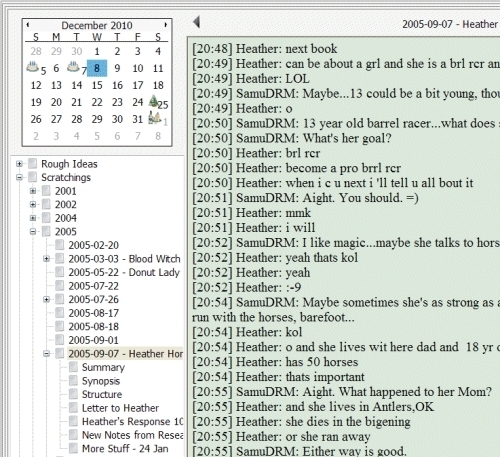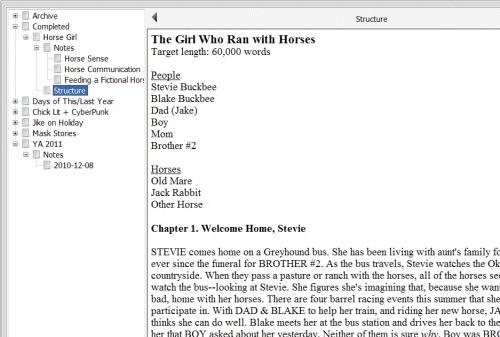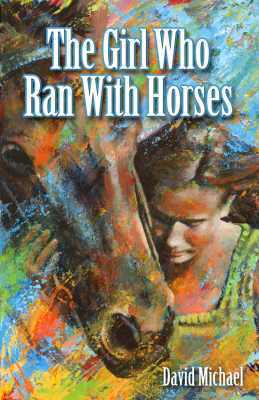How I Used The Journal to Write THE GIRL WHO RAN WITH HORSES
NOTE: I wrote this for The Journal's December 2010 Newsletter. I decided I'd post it here too.

In late 2005, as I was finishing up a novel, my 13-year-old niece, Heather, told me that my next book should be "about a grl and she is a brl rcr and she iz jus like ME" (translation: "about a girl who is a barrel racer just like me").
Heather actually told me a lot more than that. I recorded our IM conversation in The Journal as the first my many notes for the project:

I started with that chat log, and used it as the root entry for a collection of notes about the story: the summary, a rough outline, research, and even some correspondence with Heather (where I had her come up with names for most of the horses).
When I (finally) decided to start work on this book in January 2007, I created a new set of entries for it in what I call my "Development" category (which is also a loose-leaf category):

I linked to my original notes, then copied over the rough line into a new entry and began fleshing it out:

Most of the sub-entries under "Notes" for the Horse Girl project were from my research into horses and horse ranching. I'll admit it: I'm a city boy. I've ridden horses only a few times in my life, and never as an adult. I had a lot of research to do, even just for the outline. I kept track of most of it here. I would copy the link to the articles I found–and usually I would copy the entire text of the article (and most of the images) into an entry. Because you never know if Web articles are gonna stay where you found them.
Once I was happy with my outline, I created a separate loose-leaf category for this project where I would do the real work of writing a book: the actual writing.
I called the new category "Horse Girl" (because that's much less effort to type and takes up a lot less tab space). I created a some root-level entries to help keep things organized. You can see those here:

For those of you keeping count, what I cleverly call "Outline – Draft 1″ in the above screen shot is about draft, oh, 4 by this time. But it's the first draft I created in this category.
 And, yes, the outline evolved over the course of writing the book. For some reason, though, I didn't keep draft copies.
And, yes, the outline evolved over the course of writing the book. For some reason, though, I didn't keep draft copies.I used a series of entries to manage the actual manuscript: A top-level "Manuscript" entry, a sub-entry for each separate draft, and then separate sub-sub-entries for each chapter. I used this structure because it greatly simplified exporting the entire manuscript draft to a single file. Plus, I could copy the "Draft" entry and all sub-entries (right-click the "Draft …" entry and choose "Copy Entry to Clipboard") and then paste them into a new entry and sub-entries (right-click on the entry again and choose "Paste Entry from Clipboard"). A quick rename of the newly pasted entry to reflect the new draft number, and I was good to go.
I also created a "Thoughts" entry where I could leave date-stamped notes to myself as I went along. And I created the "Notes" entry where I added further research links and images (I do a lot of what you might call "just-in-time research", usually via Google, that happens in the middle of a day's writing).
I'm sure you've noticed the "Publisher Hunt" entry, which has sub-entries as well. Under there I put drafts of my query letter (there were several) and compiled the list of publishers I wanted to submit to. For each publisher, I collected their mailing address, Web page, and submission requirements in separate entries (one per publisher). I also tracked my submission history, including what kind of response I received (most of them were form rejections; c'est la vie).
Yes, I'm a bit of a text-oriented packrat. If I wrote it, I like to keep it handy. Fortunately, The Journal makes it easy (if I do say so myself) to hang onto all of those notes and scraps of information I accumulate–and organize them so they don't clutter up my workspace.
And that's about it. I made heavy use of loose-leaf categories and entries to formulate, plan and write The Girl Who Ran With Horses.

In November 2010, I released The Girl Who Ran With Horses as an independently published novel, available in both trade paperback and ebook formats.

The Girl Who Ran With Horses
Welcome Home, Stevie!
It's summer vacation and all 13-year-old Stevie Buckbee wants is to be close to her family again and to ride her horses–especially Jack Rabbit, her first horse all her own. But past tragedies threaten her plans before the summer even begins. Even as she discovers that she is somehow able to communicate with Jack Rabbit and the other horses on the family ranch, she finds she can no longer get through to her Dad and brother Blake. And what good is it to be able to run with the horses if no matter how fast and how far she runs, everything she knows and loves is lost?
The Girl Who Ran With Horses Edition
Price
Trade paperback (Amazon)
$9.99
Kindle edition (Amazon)
$3.99
Nook edition (Barnes & Noble)
$3.99
Ebook (Smashwords)
$3.99
Published on December 10, 2010 14:29
No comments have been added yet.



